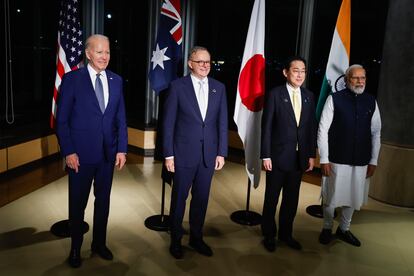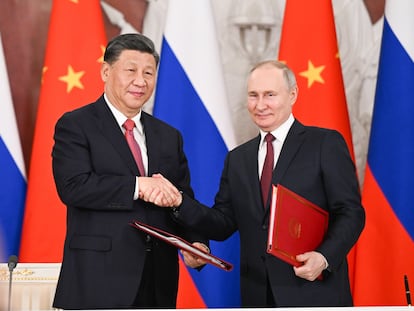US designs new security architecture to respond to the rise of China and the war in Ukraine
Washington is strengthening traditional alliances such as NATO, while in the Asia Pacific it is forging new networks with more limited objectives


The war in Ukraine — in addition to the rise of China — has put a definitive end to the world order that emerged after the end of the Cold War and has forced the United States to rethink its security structures. A new architecture is emerging, not only in the Asia Pacific, where the U.S. has its eye on Taiwan, but also in other regions. While traditional alliances such as NATO are modernizing, Washington is weaving a whole network of new or recovered groupings — from the Quadrilateral Security Dialogue between Australia, India, Japan and the United States, commonly known as the Quad, to the recently signed Atlantic Declaration that strengthens economic ties with London. These are smaller, more flexible groups with more limited objectives.
The United States claims that there is a close overlap of interests with the partner countries, both in Europe and in the Indo-Pacific, which see the war in Ukraine as a reflection of what may happen to Taiwan, the self-governing island that China considers part of its territory and on which it exerts increasing pressure.
The war “has led us to recognize, in the Indo-Pacific and in Europe, the importance of alliances, of the ties between the two regions, and to recognize that what happens to one region has direct and powerful implications on the other,” said Kurt Campbell, the White House’s coordinator for the Indo-Pacific, in a recent meeting with European experts at the Center for International Strategic Studies (CSIS) in Washington.
In Europe, this strategy is reflected in the strengthening and modernization of NATO ― which remains a pillar of U.S. foreign and defense policy ―, but also in the strengthening of the U.S. historic ties with the United Kingdom and Eastern countries, in particular Poland.

But the bulk of the Washington’s efforts are focused on the Asia Pacific region, where China’s growing influence has the greatest impact and where every gesture from the U.S. is taken with Beijing — and Taiwan — in mind: from the restrictions on semiconductor exports to China to its notable increase — in number and intensity — of military exercises and security pacts in the region.
Faced with what it perceives as the growing threat from China — which already has more ships than the U.S. —, Washington is aiming to increase its deterrent power. A difficult feat, when they are on opposite sides of the globe.
To address this, the U.S. is trying to access more bases in the Indo-Pacific. It is also putting pressure on its European allies to expand their presence in the region: France, Germany and the United Kingdom have already sent patrols — a move that “signals the European interest and adds to the deterrent power,” said Chris Johnstone, of CSIS. Likewise, Washington is seeking to strengthen the military capacity of its allies in the Indo-Pacific through greater integration of the respective defense industries. In certain cases, this includes the transfer of technology, as is the case of Aukus, the trilateral alliance with the United Kingdom and Australia that will equip Canberra with nuclear-powered submarines.
The idea is to “make U.S. forces more mobile, more distributed, more resilient,” Ely Ratner, the Pentagon’s assistant secretary of defense for Indo-Pacific Security Affairs, said at a recent talk organized by the Center for a New American Security (CNAS) in Washington.

This network is very different from the European model: it would be unthinkable to have a large military alliance like NATO would in the Indo-Pacific. Washington instead is opting for another type of relationship, which experts describe as “minilateral.” In other words, alliances between groups of smaller countries — there tend to be three or four — with more specific objectives that can be expanded if necessary. Aukus and the revived Quad fall into this category. As does the trilateral partnership between the U.S., Japan and the Philippines, and between Tokyo, Seoul and Washington. The United States has also relaunched the forum of South Pacific island nations in response to Beijing’s diplomatic efforts to win over the strategically important archipelagos.
These partnerships, according to Jeffrey Hornung from the think tank Rand, “fill a void” and “give like-minded countries the chance to tackle issues of common interest that aren’t covered in large multilateral meetings.”
Above all, they are more flexible. Members, in turn, establish similar relationships with other states, making the network of alliances more and more intertwined, adds Hornung, who predicts this type of model will rise and play “an important role in times of peace.”
The model has aroused interest in other nations. On his last trip to Europe, U.S. President Joe Biden met with the nine Eastern European members of NATO. Poland’s Deputy Minister for Foreign Affairs Piotr Wawrzyk suggested the governments of the Weimar Triangle — Paris, Berlin and Warsaw — collaborate with Washington to shape the new security architecture after the war in Ukraine.
Security agreements
U.S. efforts in the Asia Pacific are already bearing fruit. According to Ratner, “we’re starting to really see that those links are playing out in a very important way.”
In the Philippines, the election of Ferdinand Marcos Jr. has given rise to a new rapprochement after years of estrangement during the rule of Rodrigo Duterte. The United States has signed an agreement with the Philippines that gives it access to four additional bases in the country, three of them on Luzon, one of the closest islands in the archipelago to Taiwan.
Japan signed a pact in January to strengthen its defense alliance with the United States, which will send an elite unit to Okinawa, the part of Japan that is closest to Taiwan. Washington has also welcomed Japan’s new policy of military expansion — a change of direction in a country that has been pacifist since 1945. As part of this policy, Tokyo will buy more U.S. weapons, including Tomahawk missiles.
In South Korea, President Yoon Seuk-yol’s visit to Washington reinforced the nuclear umbrella with which the U.S. protects the country from possible attacks from the north. And Australia, in addition to getting nuclear submarines, will host rotations of U.S. military aircraft.
The U.S. is now hoping to win over India, which is a partner in the informal Quad partnership but has important defense ties to Moscow. Indian Prime Minister Narendra Modi is visiting Washington this week, and the U.S. is rolling out the red carpet: Modi will be offered a state visit with all kinds of entertainment, from a speech in Congress to a gala dinner. Security agreements, especially for the co-production and co-development of weapons, are also on the table.
If these deals are made, it would be a huge step for the U.S.’ relationship with India. New Delhi needs new weapons and systems to counter China’s breakneck military modernization. But at the same time, India has always tried to keep Washington at a cautious distance.
India “seeks to acquire advanced technologies from the United States to bolster its own economic and military capabilities and thus facilitate its rise as a great power capable of balancing China independently, but it does not presume that American assistance imposes any further obligations on itself,” Ashley Tellis, from the Carnegie Endowment for International Peace, wrote in Foreign Affairs magazine last month.
Security beyond defense
The new architecture is not limited to the traditional concept of security. It also includes areas such as energy and economic security. The buzzword in the halls of the White House and in Congress is “derisk” or risk reduction, which is understood as a way to shield against financial or commercial coercive measures that other governments — such as China or Russia — may want to impose. An often-cited example is the boycott that Beijing imposed on Lithuania, and is still ongoing, after Riga allowed an unofficial Taiwanese embassy to open on its soil.
Tu suscripción se está usando en otro dispositivo
¿Quieres añadir otro usuario a tu suscripción?
Si continúas leyendo en este dispositivo, no se podrá leer en el otro.
FlechaTu suscripción se está usando en otro dispositivo y solo puedes acceder a EL PAÍS desde un dispositivo a la vez.
Si quieres compartir tu cuenta, cambia tu suscripción a la modalidad Premium, así podrás añadir otro usuario. Cada uno accederá con su propia cuenta de email, lo que os permitirá personalizar vuestra experiencia en EL PAÍS.
¿Tienes una suscripción de empresa? Accede aquí para contratar más cuentas.
En el caso de no saber quién está usando tu cuenta, te recomendamos cambiar tu contraseña aquí.
Si decides continuar compartiendo tu cuenta, este mensaje se mostrará en tu dispositivo y en el de la otra persona que está usando tu cuenta de forma indefinida, afectando a tu experiencia de lectura. Puedes consultar aquí los términos y condiciones de la suscripción digital.
More information
Archived In
Últimas noticias
Most viewed
- David King, chemist: ‘There are scientists studying how to cool the planet; nobody should stop these experiments from happening’
- Reinhard Genzel, Nobel laureate in physics: ‘One-minute videos will never give you the truth’
- Mexico completes its trade shift with the entry into force of tariffs on China and countries without trade agreements
- Oona Chaplin: ‘I told James Cameron that I was living in a treehouse and starting a permaculture project with a friend’
- Sinaloa Cartel war is taking its toll on Los Chapitos









































